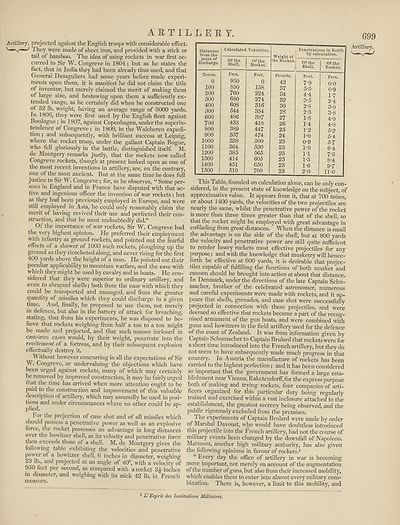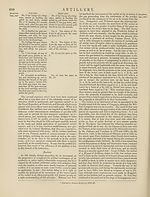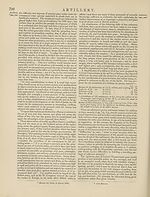Encyclopaedia Britannica > Volume 3, Anatomy-Astronomy
(707) Page 699
Download files
Complete book:
Individual page:
Thumbnail gallery: Grid view | List view

ARTILLERY.
Artillery, projected against the English troops with considerable effect.
They were made of sheet iron, and provided with a stick or
tail of bamboo. The idea of using rockets in war first oc¬
curred to Sir W. Congreve in 1804 ; but as he states the
fact, that in India they had been already thus used, and that
General Desaguliers had some years before made experi¬
ments upon them, it is manifest he did not claim the title
of inventor, but merely claimed the merit of making them
of large size, and bestowing upon them a sufficiently ex¬
tended range, as he certainly did when he constructed one
of 32 lb. weight, having an average range of 3000 yards.
In 1808, they were first used by the English fleet against
Boulogne ; in 1807, against Copenhagen, under the superin¬
tendence of Congreve; in 1809, in the Walcheren expedi¬
tion ; and subsequently, with brilliant success at Leipzig,
where the rocket troop, under the gallant Captain Bogue,
who fell gloriously in the battle, distinguished itself. M.
de Montgery remarks justly, that the rockets now called
Congreve rockets, though at present looked upon as one of
the most recent inventions in artillery, are, on the contrary,
one of the most ancient. But at the same time he does full
justice to Sir W. Congreve ; for, as he observes, “ Some per¬
sons in England and in France have disputed with that ac¬
tive and ingenious officer the invention of war rockets; but
as they had been previously employed in Europe, and were
still employed in Asia, he could only reasonably claim the
merit of having revived their use and perfected their con¬
struction, and that he most undoubtedly did.”
Of the importance of war rockets, Sir W. Congreve had
the very highest opinion. He preferred their employment
with infantry as ground rockets, and pointed out the fearful
effects of a shower of 1000 such rockets, ploughing up the
ground as they ricocheted along, and never rising for the first
400 yards above the height of a man. He pointed out their
peculiar applicability to mountain warfare, and the ease with
which they might be used by cavalry and in boats. He con¬
sidered that they were superior to ordinary artillery, and
even to shrapnel shells; both from the ease with which they
could be transported and managed, and from the greater
quantity of missiles which they could discharge in a given
time. And, finally, he proposed to use them, not merely
in defence, but also in the battery of attack for breaching,
stating, that from his experiments, he was disposed to be¬
lieve that rockets weighing from half a ton to a ton might
be made and projected, and that such masses inclosed in
cast-iron cases would, by their weight, penetrate into the
revetement of a fortress, and by their subsequent explosion
effectually destroy it.
\\ ithout however concurring in all the expectations of Sir
W. Congreve, or undervaluing the objections which have
been urged against rockets, many of which may certainly
be removed by improved construction, it may be fairly urged
that the time has arrived when more attention ought to be
paid to the construction and improvement of this valuable
description of artillery, which may assuredly be used in posi¬
tions and under circumstances where no other could be ap¬
plied.
for the projection of case shot and of all missiles which
should possess a penetrative power as well as an explosive
force, the rocket possesses an advantage in long distances
over the howitzer shell, as its velocity and penetrative force
then exceeds those of a shell. M. de Montgery gives the
following table exhibiting the velocities and penetrative
power of a howitzer shell, 6 inches in diameter, weighing
23 lb., and projected at an angle of 40°, with a velocity of
950 feet pei second, as compared with a rocket 3^- inches
in diameter, and weighing with its stick 42 lb. in French
measure.
Distances
from the
point of
discharge.
Toises.
0
100
200
300
400
500
600
700
800
900
1000
1100
1200
1300
1400
1500
Calculated Velocities
Of the Of the
Shell. Rocket.
Feet.
950
850
760
680
608
544
486
435
389
357
338
364
385
414
451
510
Feet.
0
158
224
274
316
354
387
418
447
474
500
530
565
605
650
700
Weight of |
the Rocket.
I Penetrations in Earth
hy calculation.
Of the
Shell.
Pounds.
42
37
34
32
30
28
27
26
25
24
23
23
23
23
23
23
Feet.
7-0
5-5
4-4
3-5
2-8
2-3
1-8
1-4
1-2
1-0
0-9
1-0
IT
1- 3
1-6
2- 0
Of the
Rocket.
Feet.
0-0
0-9
1- 7
2- 4
3- 0
3- 8
4- 0
4- 8
5- 2
5-4
5- 7
6- 4
7- 3
8- 4
9- 7
11-0
699
Artillery.
This Table, founded on calculation alone, can be only con¬
sidered, in the present state of knowledge on the subject, of
approximative value. It appears from it, that at 700 toises,
or about 1400 yards, the velocities of the two projectiles are
nearly the same, whilst the penetrative power of the rocket
is more than three times greater than that of the shell, so
that the rocket might be employed with great advantage in
enfilading from great distances. When the distance is small
the advantage is on the side of the shell, but at 800 yards
the velocity and penetrative power are still quite sufficient
to render heavy rockets most effective projectiles for any
purpose; and with the knowledge that musketry will hence¬
forth be effective at 600 yards, it is desirable that projec¬
tiles capable of fulfilling the functions of both musket and
cannon should be brought into action at about that distance.
In Denmark, under the directions of the late Captain Schu¬
macher, brother of the celebrated astronomer, numerous
and careful experiments were made with rockets, and it ap¬
pears that shells, grenades, and case shot were successfully
projected in connection with these projectiles, and were
deemed so effective that rockets became a part of the recog¬
nised armament of the gun boats, and were combined with
guns and howitzers in the field artillery used for the defence
of the coast of Zealand. It was from information given by
Captain Schumacher to Captain Brulard that rockets were for
a short time introduced into the French artillery, but they do
not seem to have subsequently made much progress in that
country. In Austria the manufacture of rockets has been
carried to the highest perfection; and it has been considered
so important that the government has formed a large esta¬
blishment near Vienna, Raketendorff, for the express purpose
both of making and trying rockets, four companies of arti¬
ficers organized for this particular duty being regularly
trained and exercised within a vast inclosure attached to the
establishment, the greatest secrecy being observed, and the
public rigorously excluded from the premises.
The experiments of Captain Brulard were made by order
of Marshal Davoust, who would have doubtless introduced
this projectile into the French artillery, had not the course of
military events been changed by the downfall of Napoleon.
Marmont, another high military authority, has also given
the following opinions in favour of rockets.1
“ Every day the office of artillery in war is becoming
more important, not merely on account of the augmentation
of the number of guns, but also from their increased mobility,
which enables them to enter into almost every military com¬
bination. There is, however, a limit to this mobility, and
1 L: Esprit des Institutions Militaires.
Artillery, projected against the English troops with considerable effect.
They were made of sheet iron, and provided with a stick or
tail of bamboo. The idea of using rockets in war first oc¬
curred to Sir W. Congreve in 1804 ; but as he states the
fact, that in India they had been already thus used, and that
General Desaguliers had some years before made experi¬
ments upon them, it is manifest he did not claim the title
of inventor, but merely claimed the merit of making them
of large size, and bestowing upon them a sufficiently ex¬
tended range, as he certainly did when he constructed one
of 32 lb. weight, having an average range of 3000 yards.
In 1808, they were first used by the English fleet against
Boulogne ; in 1807, against Copenhagen, under the superin¬
tendence of Congreve; in 1809, in the Walcheren expedi¬
tion ; and subsequently, with brilliant success at Leipzig,
where the rocket troop, under the gallant Captain Bogue,
who fell gloriously in the battle, distinguished itself. M.
de Montgery remarks justly, that the rockets now called
Congreve rockets, though at present looked upon as one of
the most recent inventions in artillery, are, on the contrary,
one of the most ancient. But at the same time he does full
justice to Sir W. Congreve ; for, as he observes, “ Some per¬
sons in England and in France have disputed with that ac¬
tive and ingenious officer the invention of war rockets; but
as they had been previously employed in Europe, and were
still employed in Asia, he could only reasonably claim the
merit of having revived their use and perfected their con¬
struction, and that he most undoubtedly did.”
Of the importance of war rockets, Sir W. Congreve had
the very highest opinion. He preferred their employment
with infantry as ground rockets, and pointed out the fearful
effects of a shower of 1000 such rockets, ploughing up the
ground as they ricocheted along, and never rising for the first
400 yards above the height of a man. He pointed out their
peculiar applicability to mountain warfare, and the ease with
which they might be used by cavalry and in boats. He con¬
sidered that they were superior to ordinary artillery, and
even to shrapnel shells; both from the ease with which they
could be transported and managed, and from the greater
quantity of missiles which they could discharge in a given
time. And, finally, he proposed to use them, not merely
in defence, but also in the battery of attack for breaching,
stating, that from his experiments, he was disposed to be¬
lieve that rockets weighing from half a ton to a ton might
be made and projected, and that such masses inclosed in
cast-iron cases would, by their weight, penetrate into the
revetement of a fortress, and by their subsequent explosion
effectually destroy it.
\\ ithout however concurring in all the expectations of Sir
W. Congreve, or undervaluing the objections which have
been urged against rockets, many of which may certainly
be removed by improved construction, it may be fairly urged
that the time has arrived when more attention ought to be
paid to the construction and improvement of this valuable
description of artillery, which may assuredly be used in posi¬
tions and under circumstances where no other could be ap¬
plied.
for the projection of case shot and of all missiles which
should possess a penetrative power as well as an explosive
force, the rocket possesses an advantage in long distances
over the howitzer shell, as its velocity and penetrative force
then exceeds those of a shell. M. de Montgery gives the
following table exhibiting the velocities and penetrative
power of a howitzer shell, 6 inches in diameter, weighing
23 lb., and projected at an angle of 40°, with a velocity of
950 feet pei second, as compared with a rocket 3^- inches
in diameter, and weighing with its stick 42 lb. in French
measure.
Distances
from the
point of
discharge.
Toises.
0
100
200
300
400
500
600
700
800
900
1000
1100
1200
1300
1400
1500
Calculated Velocities
Of the Of the
Shell. Rocket.
Feet.
950
850
760
680
608
544
486
435
389
357
338
364
385
414
451
510
Feet.
0
158
224
274
316
354
387
418
447
474
500
530
565
605
650
700
Weight of |
the Rocket.
I Penetrations in Earth
hy calculation.
Of the
Shell.
Pounds.
42
37
34
32
30
28
27
26
25
24
23
23
23
23
23
23
Feet.
7-0
5-5
4-4
3-5
2-8
2-3
1-8
1-4
1-2
1-0
0-9
1-0
IT
1- 3
1-6
2- 0
Of the
Rocket.
Feet.
0-0
0-9
1- 7
2- 4
3- 0
3- 8
4- 0
4- 8
5- 2
5-4
5- 7
6- 4
7- 3
8- 4
9- 7
11-0
699
Artillery.
This Table, founded on calculation alone, can be only con¬
sidered, in the present state of knowledge on the subject, of
approximative value. It appears from it, that at 700 toises,
or about 1400 yards, the velocities of the two projectiles are
nearly the same, whilst the penetrative power of the rocket
is more than three times greater than that of the shell, so
that the rocket might be employed with great advantage in
enfilading from great distances. When the distance is small
the advantage is on the side of the shell, but at 800 yards
the velocity and penetrative power are still quite sufficient
to render heavy rockets most effective projectiles for any
purpose; and with the knowledge that musketry will hence¬
forth be effective at 600 yards, it is desirable that projec¬
tiles capable of fulfilling the functions of both musket and
cannon should be brought into action at about that distance.
In Denmark, under the directions of the late Captain Schu¬
macher, brother of the celebrated astronomer, numerous
and careful experiments were made with rockets, and it ap¬
pears that shells, grenades, and case shot were successfully
projected in connection with these projectiles, and were
deemed so effective that rockets became a part of the recog¬
nised armament of the gun boats, and were combined with
guns and howitzers in the field artillery used for the defence
of the coast of Zealand. It was from information given by
Captain Schumacher to Captain Brulard that rockets were for
a short time introduced into the French artillery, but they do
not seem to have subsequently made much progress in that
country. In Austria the manufacture of rockets has been
carried to the highest perfection; and it has been considered
so important that the government has formed a large esta¬
blishment near Vienna, Raketendorff, for the express purpose
both of making and trying rockets, four companies of arti¬
ficers organized for this particular duty being regularly
trained and exercised within a vast inclosure attached to the
establishment, the greatest secrecy being observed, and the
public rigorously excluded from the premises.
The experiments of Captain Brulard were made by order
of Marshal Davoust, who would have doubtless introduced
this projectile into the French artillery, had not the course of
military events been changed by the downfall of Napoleon.
Marmont, another high military authority, has also given
the following opinions in favour of rockets.1
“ Every day the office of artillery in war is becoming
more important, not merely on account of the augmentation
of the number of guns, but also from their increased mobility,
which enables them to enter into almost every military com¬
bination. There is, however, a limit to this mobility, and
1 L: Esprit des Institutions Militaires.
Set display mode to:
![]() Universal Viewer |
Universal Viewer | ![]() Mirador |
Large image | Transcription
Mirador |
Large image | Transcription
Images and transcriptions on this page, including medium image downloads, may be used under the Creative Commons Attribution 4.0 International Licence unless otherwise stated. ![]()
| Encyclopaedia Britannica > Encyclopaedia Britannica > Volume 3, Anatomy-Astronomy > (707) Page 699 |
|---|
| Permanent URL | https://digital.nls.uk/193766539 |
|---|
| Attribution and copyright: |
|
|---|---|
| Shelfmark | EB.16 |
|---|---|
| Description | Ten editions of 'Encyclopaedia Britannica', issued from 1768-1903, in 231 volumes. Originally issued in 100 weekly parts (3 volumes) between 1768 and 1771 by publishers: Colin Macfarquhar and Andrew Bell (Edinburgh); editor: William Smellie: engraver: Andrew Bell. Expanded editions in the 19th century featured more volumes and contributions from leading experts in their fields. Managed and published in Edinburgh up to the 9th edition (25 volumes, from 1875-1889); the 10th edition (1902-1903) re-issued the 9th edition, with 11 supplementary volumes. |
|---|---|
| Additional NLS resources: |
|

